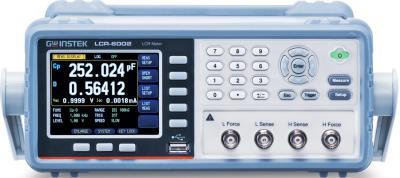
|
|
The Instek LCR-6002 2kHz LCR Meter has a 3.5-inch color LCD to simultaneously display setting criteria and measurement results, it increases two additional monitoring parameters. In other words, there are four parameters, primary/secondary and two monitoring, simultaneously shown on the screen that tremendously enhances the measurement efficiency. The enlarge display mode not only emphasizes the measurement results, but also provides PASS/FAIL judgment to facilitate a rapid and convenient test result.
Specifications.
Test Frequency: 10Hz to 2kHz(±0.01%) (4 digits resolution).
Output impedance: 30Ω / 50Ω / 100Ω selectable.
Basic Accuracy: 0.05% (Slow / Med), 0.1% (Fast).
Test Speed: FAST:25ms / MED:100ms / SLOW:333ms.
Test Signal Levels.
AC Voltage: 10.00mV to 2.00V (±10%), CV 10.00mV- to 2.00V (±6%).
AC Current: 100.0μA to 20.00mA (±10%), CC 100.0μA to 20.00mA (±6%) (@2VMax).
DCR: +2V, 0.066A (Max.), Output impedance fixed 30Ω.
DC Bias Internal: ±2.5V (0.5%+0.005V).
Display Range.
R, X, |Z|: 0.00001Ω ~ 99.9999MΩ,
G, B, |Y|: 0.01nS ~ 999.999S,
L: 0.00001μH ~ 9999.99H,
C: 0.00001pF ~ 9999.99mF,
D: 0.00001 ~ 9.99999,
Q: 0.00001 ~ 99999.9,
θd: -179.999° ~ 179.999°,
θr: -3.14159 ~ 3.14159,
DCR: 0.00001Ω ~ 99.9999MΩ,
Δ%: -99999% ~ 99999%.
Test Mode Combinations (16): Cs-Rs, Cs-D, Cp-Rp, Cp-D, Lp-Rp, Lp-Q, Ls-Rs, Ls-Q, Rs-Q, Rp-Q, R-X, Z-θr, Z-θd, Z-D, Z-Q, DCR.
|